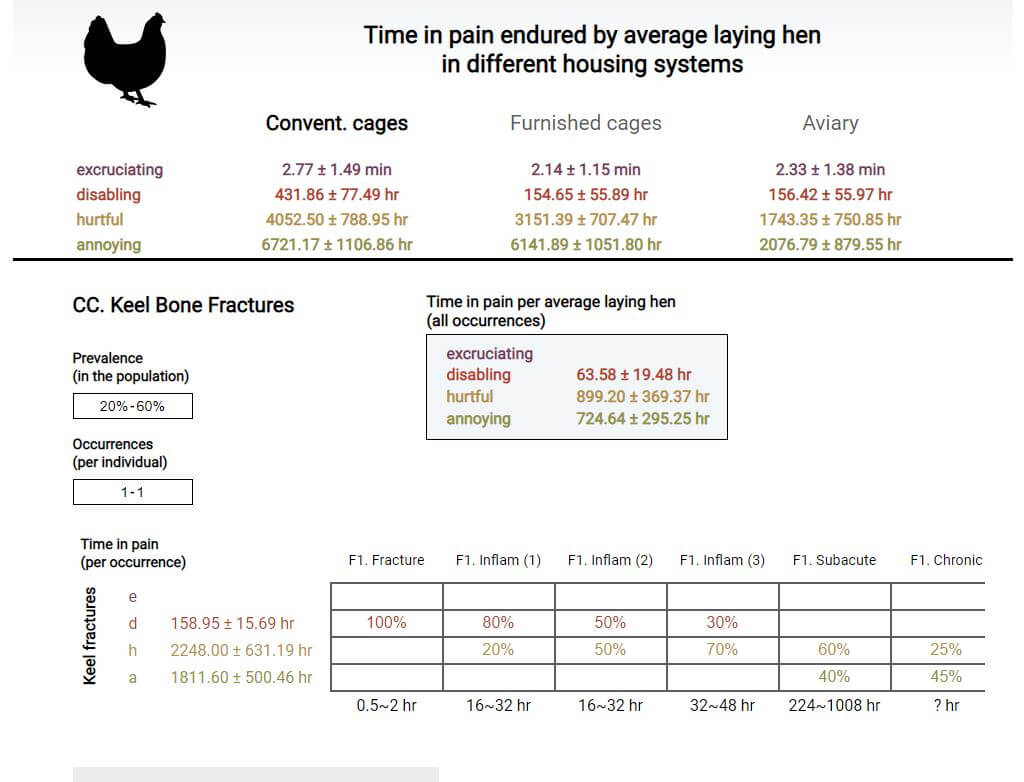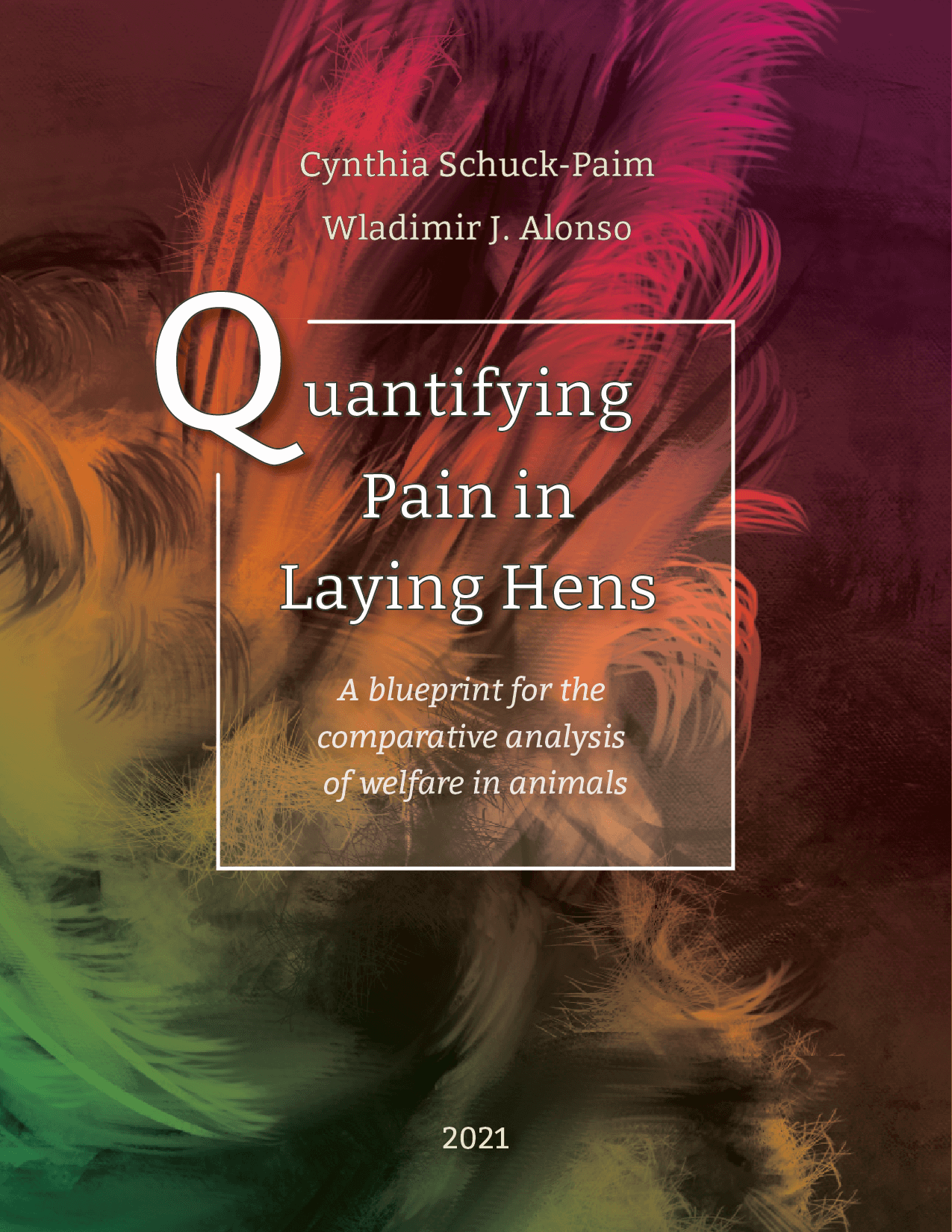The global production of eggs has reached 83 million tonnes in 2019, up from 19 million tonnes in 1970. This amounts to over 1.5 trillion eggs produced every year by a population of approximately 7.5 billion laying hens – a group of animals now as abundant as humans.
Productivity gains in the egg industry have stemmed predominantly from the selection of highly productive breeds, along with the manufacturing of highly specialized diets and additives designed to maximize feed conversion. Commercial layer lines now lay about 320 eggs over a period of 70-80 weeks, compared to about 80 eggs per year in 1900. The industry’s goal goes further, as it aims to reach an average production of 500 eggs per laying hen in about 100 weeks.
In addition to massive increases in output per animal within a few decades, major shifts in raising methods included the confinement of animals at high densities in closed and barren environments. In the case of laying hens, confinement has reached extreme levels through the adoption of cage systems (also known as battery cages). This system restricts hens’ space provided to approximately 430 to 450 cm2 per bird, an area smaller than an A4 sheet of paper. As of 2021, most laying hens still spend their entire lives in these cages.
Extreme confinement and over-selection for early, elevated and extended egg production takes a heavy toll on the health of laying hens, with a high incidence of metabolic and bone disorders, among other physical and psychological challenges associated with acute and chronic pain.
However, public attention to the welfare of laying hens over the previous decades has been fostering a transition away from conventional battery cage systems, with an increase in the proportion of furnished cages (which provide hens with some additional space, a nest, and perches) and cage-free systems in some countries, either through legislation or corporate commitments for the sourcing of cage-free eggs.
In this project, we apply our analytical framework to quantify the welfare impact of cage-free reforms, as measured by the cumulative time in pain (i.e. affective states of negative valence) potentially averted for every laying hen raised in an aviary instead of a cage.
A summary of key findings, and charts, is available below, and has been also featured in Our World in Data.
Our analysis focuses on conventional cages, furnished cages and indoor aviary systems (single-tier and multi-tier), considered by the industry as the preferred cage-free alternative for large scale egg production. For each housing system, we estimated the total time an average laying hen spends in different categories of pain intensity based on the intensity and duration of the pain endured from key welfare harms and their typical prevalence in commercial flocks. In all cases, the analysis is focused on the laying phase, which was assumed to last 40 to 60 weeks (hence the assumed lifespan, considering a pre-laying phase of about 20 weeks, is approximately 60 to 80 weeks for all systems).
Instead of considering an exhaustive list of every possible harm affecting commercial layers, we examined key sources of physical and psychological pain arising from the most serious welfare problems, particularly those likely to be affected by the transition from cages to cage-free aviaries. Among these are keel bone fractures, injurious pecking (e.g. skin wounds, vent wounds, cannibalism), the deprivation of a number of highly motivated behaviors and egg peritonitis syndrome (the most common production disease in modern breeds of laying hens and the leading cause of mortality). We also quantify the cumulative time in pain resulting from the process of depopulation and transport, as it remains one of the most serious welfare problems in the poultry industry. Estimates of time in pain should be therefore viewed as the minimum time in pain endured by laying hens, during the laying phase, in the different systems analysed.
Experiences of pain perceived as aversive, but not intense enough to disrupt the animal’s routine in a way that alters adaptive functioning or affects the behaviors that animals are motivated to perform. Similarly, Annoying pain should not deter individuals from enjoying pleasant experiences with no short-term function (e.g., play) and positive social interactions. Sufferers can ignore this sensation most of the time. Performance of cognitive tasks demanding attention are either not affected or only mildly affected. Physiological departures from expected baseline values are not expected to be present. Vocalizations and other overt expressions of pain should not be observed.
Experiences of pain in this category disrupt the ability of individuals to function optimally. Different from Annoying pain, the ability to draw attention away from the sensation of pain is reduced: awareness of pain is likely to be present most of the time, interspersed by brief periods during which pain can be ignored depending on the level of distraction provided by other activities. Individuals can still conduct routine activities that are important in the short-term (e.g. eating, foraging) and perform cognitively demanding tasks, but an impairment in their ability or motivation to do so is likely to be observed. Although animals may still engage in behaviors they are strongly motivated to perform (i.e., exploratory, comfort, sexual, and maintenance behaviors), their frequency or duration is likely to be reduced. Engagement in positive activities with no immediate benefits (e.g., play in piglets, dustbathing in chickens) is not expected. Reduced alertness and inattention to ongoing stimuli may be present. The effect of (effective) drugs (e.g., analgesics if the pain is physical, psychotropic drugs in the case of psychological pain) in the alleviation of symptoms is expected.
Pain at this level takes priority over most bids for behavioral execution and prevents all forms of enjoyment or positive welfare. Pain is continuously distressing. Individuals affected by harms in this category often change their activity levels drastically (the degree of disruption in the ability of an organism to function optimally should not be confused with the overt expression of pain behaviors, which is less likely in prey species). Inattention and unresponsiveness to ongoing stimuli and surroundings are likely to be observed. Relief often requires higher drug dosages or more powerful drugs. The term Disabling refers to the disability caused by ‘pain’, not to any structural disability.
All conditions and events associated with extreme levels of pain that are not normally tolerated even if only for a few seconds. In humans, it would mark the threshold of pain under which many people choose to take their lives rather than endure the pain. This is the case, for example, of scalding and severe burning events. Behavioral patterns associated with experiences in this category may include loud screaming, involuntary shaking, extreme muscle tension, or extreme restlessness. Another criterion is the manifestation of behaviors that individuals would strongly refrain from displaying under normal circumstances, as they threaten body integrity (e.g. running into hazardous areas or exposing oneself to sources of danger, such as predators, as a result of pain or of attempts to alleviate it). The attribution of conditions to this level must therefore be done cautiously. Concealment of pain is not possible.
Although pain inherently concerns individuals, we operationally accept that the collective welfare of the members of a population can also be determined. Measuring cumulative pain at the population level is also necessary to account for the heterogeneity in the exposure of population members to different challenges. For example, while lameness is experienced by a large fraction of broiler chickens, fatal cases of ascites are only experienced by a few. Therefore, measurement efforts must consider the prevalence of each welfare challenge, so that pain is determined for the average member of the population (which may not necessarily correspond to any real organism). At the population level, the time spent at each level of pain intensity as a result of each challenge is determined by multiplying it by its prevalence. For example, if a condition causes 10 hours of Disabling pain and 70% of the population are affected, then the average member of this population could be said to experience 7 hours of Disabling pain due to the condition. Measurements at the population level enable comparing the impact of different practices and conditions across demographics, geographies, and time.
The analysis primarily aimed to estimate the minimum welfare improvement associated with transitioning to cage-free housing. In this sense, we preferred to err on the side of caution than potentially overestimated reform benefits in any particular aspect. Thus, it is reasonable to anticipate that the actual benefits of this transition may surpass the estimates. This expectation is supported by the following factors:
All parameter values used for the analysis (estimates of duration, intensity, number of occurrences and the prevalence of each welfare offense) are justified in the book “Quantifying Pain in Laying Hens” (see below). However, we invite the reader to examine the extent to which the estimates presented here are sensitive to our choices and assumptions, at the platform https://pain-track.org/hens. In this web application, all parameter values can be altered, with the immediate update of all estimates.

All methods, assumptions, justifications and results are discussed thoroughly in the book “Quantifying pain in laying hens”, freely available for download.

